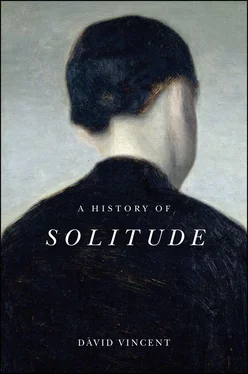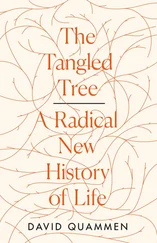States of mind in solitude and the capacity to make transitions between solitude and sociability were issues that had to be addressed by every following generation in the modernizing world. Zimmermann’s own answers were of his time and conditioned by his identity as a Protestant, urban intellectual. The urgency of his treatise stemmed from a sense of the deep instability of the prevailing balance of solitude and sociability. There was a tension in Solitude Considered between an endorsement of the emerging urban civilization and a reaction against its trivializing effects that went back to Petrarch and Virgil and forward to successive cohorts of critics as populations in Western Europe increasingly clustered in towns and cities. The efficacy of the movement between society and solitude went both ways. Those who had ‘their faculties narrowed by continual intercourse with vanity and nonsense’, Zimmermann observed, were in no fit state to ‘relish the delights of seclusion’. 79It was not just the major population centres. The treatise contains a heartfelt condemnation of the superficial dramas of provincial living, derived from its author’s long and increasingly resented sojourn in Brugg, the small town near Zurich where he was born and to which he later returned as chief medical officer. 80The danger derived from a sense that the elite culture of the period was hard-wired for retirement in the face of the excesses of urban civilization. Zimmermann both sympathized with this reaction and feared its consequences. It would be impossible to maintain the forward momentum of the associative project of the Enlightenment if its leading members were, like Rousseau, continually looking over their shoulders at the attractions of sylvan retreats.
The same was true of withdrawal for spiritual contemplation. The desert fathers and their medieval successors were in the bones of European religious sensibility. They constituted a common heritage of Catholic and Protestant alike, icons to be admired, celebrated and conceivably imitated. The ferocity of Zimmermann’s attack on ‘religious insanity’ reflected his awareness of its continuing attraction. Despite the further damage caused to the surviving networks of monasteries by the French Revolution, both in France and in the countries to which the Revolution was exported, their way of life retained a fading glamour. What continued to appeal was the extremity of the experience. If the problem was the corrupting comfort of urban culture, the answer lay in a complete denial of ease and indulgence. If the obstacle to restorative contemplation was the press of other people, the solution was a total escape, whether temporary or, in specific circumstances, permanent. In this sense, the monastic ideal was at once a particular, if increasingly uncommon, institutional possibility, and a more general inspiration of varieties of spiritual retreat. Within the Christian tradition, there were those driving a religious revival who, unlike Zimmermann, believed that a direct, personal encounter with God was a feasible path to revelations unattainable in an increasingly secular and commercial society.
There was further unease about the disruptive role of the imagination. Zimmermann understood its new-found power and that it was particularly creative when individuals withdrew to consider their own thoughts. 81‘Solitude,’ he wrote, ‘acts with continual and mighty force on the imagination, whose empire over the mind is almost always superior to that of the judgment.’ 82However it was precisely when the subject was alone that imagination was likely to overthrow judgement, unexposed as it was to the critique of rational discourse. English moralists such as the third Earl of Shaftesbury had debated whether, as Lawrence Klein writes, ‘solitude bred phantasms of the mind, of which enthusiastic delusions were but one sort’. 83Towards the end of the eighteenth century, the Romantic Movement proposed a means of focussing the imagination through an intense, frequently solitary engagement with nature. Although Zimmermann was well aware of the time-honoured duality of town and country, his discussion of the latter was perfunctory. He had limited interest in what might be termed the geography of solitude, the association of a state of retirement with a particular spatial, preferably natural, location. He came from a part of Europe that was becoming celebrated as the most awe-inspiring manifestation of the natural world, but in his own affairs he was more concerned with finding a suitable location for his medical career. Not for him the enthusiastic project of the English radical John Thelwall, who compiled The Peripatetic; Or, Sketches of the Heart, of Nature and Society three years after the first English translation of Solitude Considered :
In one respect, at least, said I, after quitting the public road, in order to pursue a path, faintly tracked through the luxuriant herbage of the fields, and which left me at liberty to indulge the solitary reveries of a mind, to which the volume of nature is ever open at some page of instruction and delight; – In one respect, at least, I may boast of a resemblance to the simplicity of the ancient sages: I pursue my meditations on foot, and can find occasion for philosophic reflection, wherever yon fretted vault (the philosopher’s best canopy) extends its glorious covering. 84
Walking had become and would remain a critical element of the construction and practice of solitude. It will be the central issue in Chapter 2on the nineteenth century and will be revisited in Chapter 5on the twentieth.
The Modern History of Solitude
The long debate over solitude was given new urgency by the Enlightenment commitment to sociability. Personal exchange drove innovation but left insufficient space for intellectual exploration and self-discovery. Social interaction promoted creativity but might also distract and trivialize if there was no opportunity for retreat and reflection. A new balance had to be struck between engagement and seclusion in the pursuit of progress. At the same time, historical forms of withdrawal retained a dangerous attraction amidst the noise and materialism of an urbanizing society. The walled cloister or unpeopled nature had long been a cleansing alternative to the corrupting pressures of the contemporary world. Both threatened an irreversible rejection of vital structures of discourse and debate. Amidst these pressures there were evident casualties of social living. There was a growing apprehension, driven by the emerging medical profession, that the mental resilience of those charged with achieving change could not withstand the maelstrom of personal interactions. The more intense the demands of society, the larger the number of participants, the greater the risk of a descent into a potentially lethal melancholy.
The question of how to be alone has remained a lightning conductor in the response to modernity. 85As European populations expanded and relocated from the country to the city after 1800, so new questions were asked in a host of contexts about the appropriate role of solitude. What James Vernon has characterized as ‘a new society of strangers’ 86was faced with the task of redefining and remaking practices which could variously be seen as compounding the dangers or exploiting the strengths of more fragmented interpersonal relations. Over time, three distinct functions of solitude emerged, each of them a response to the opportunities and threats of increasingly crowded populations.
The first of these had a lineage stretching back to the Romantic Movement and thence to oppositional practices with which Zimmermann was concerned. In this discourse, solitude was a recurring, endlessly remodelled critique of whatever was conceived as modernity. The locus of unwelcome change was the expanding urban centres which corrupted human relations and threatened physical health. The principal arena of spiritual and bodily recovery was nature in as unspoilt a form as the British Isles could supply. With the growth of international transport systems from the mid-nineteenth century onwards, it became possible to engage in person or through travel literature with truly wild landscapes. What was required above all was an unmediated relationship not between one individual and another, but between the lone walker or explorer and some manifestation of God’s original creation. This withdrawal from urban sociability is considered in Chapter 2, which is principally concerned with walking in the nineteenth century, Chapter 5, which discusses recreational encounters with the countryside in the twentieth century, and Chapter 6, which examines the increasingly exhausted practice of battling with extreme nature.
Читать дальше












